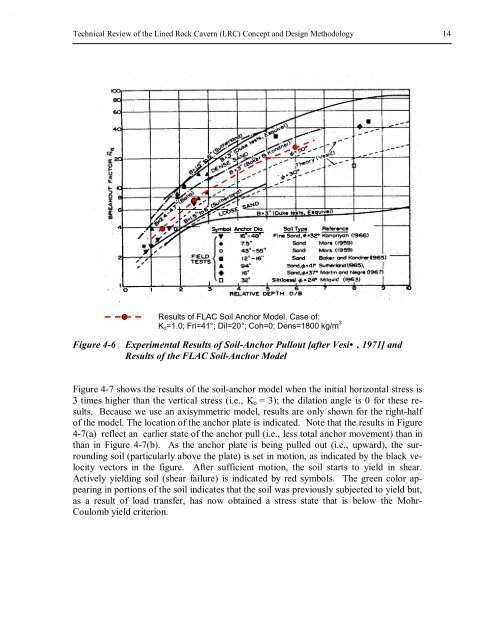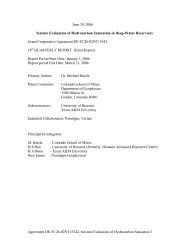Technical Review of the Lined Rock Cavern Concept and Design ...
Technical Review of the Lined Rock Cavern Concept and Design ...
Technical Review of the Lined Rock Cavern Concept and Design ...
You also want an ePaper? Increase the reach of your titles
YUMPU automatically turns print PDFs into web optimized ePapers that Google loves.
<strong>Technical</strong> <strong>Review</strong> <strong>of</strong> <strong>the</strong> <strong>Lined</strong> <strong>Rock</strong> <strong>Cavern</strong> (LRC) <strong>Concept</strong> <strong>and</strong> <strong>Design</strong> Methodology 14<br />
Results <strong>of</strong> FLAC Soil Anchor Model, Case <strong>of</strong>:<br />
Ko=1.0; Fri=41°; Dil=20°; Coh=0; Dens=1800 kg/m 3<br />
Figure 4-6 Experimental Results <strong>of</strong> Soil-Anchor Pullout [after Vesi , 1971] <strong>and</strong><br />
Results <strong>of</strong> <strong>the</strong> FLAC Soil-Anchor Model<br />
Figure 4-7 shows <strong>the</strong> results <strong>of</strong> <strong>the</strong> soil-anchor model when <strong>the</strong> initial horizontal stress is<br />
3 times higher than <strong>the</strong> vertical stress (i.e., Ko = 3); <strong>the</strong> dilation angle is 0 for <strong>the</strong>se results.<br />
Because we use an axisymmetric model, results are only shown for <strong>the</strong> right-half<br />
<strong>of</strong> <strong>the</strong> model. The location <strong>of</strong> <strong>the</strong> anchor plate is indicated. Note that <strong>the</strong> results in Figure<br />
4-7(a) reflect an earlier state <strong>of</strong> <strong>the</strong> anchor pull (i.e., less total anchor movement) than in<br />
than in Figure 4-7(b). As <strong>the</strong> anchor plate is being pulled out (i.e., upward), <strong>the</strong> surrounding<br />
soil (particularly above <strong>the</strong> plate) is set in motion, as indicated by <strong>the</strong> black velocity<br />
vectors in <strong>the</strong> figure. After sufficient motion, <strong>the</strong> soil starts to yield in shear.<br />
Actively yielding soil (shear failure) is indicated by red symbols. The green color appearing<br />
in portions <strong>of</strong> <strong>the</strong> soil indicates that <strong>the</strong> soil was previously subjected to yield but,<br />
as a result <strong>of</strong> load transfer, has now obtained a stress state that is below <strong>the</strong> Mohr-<br />
Coulomb yield criterion.

















